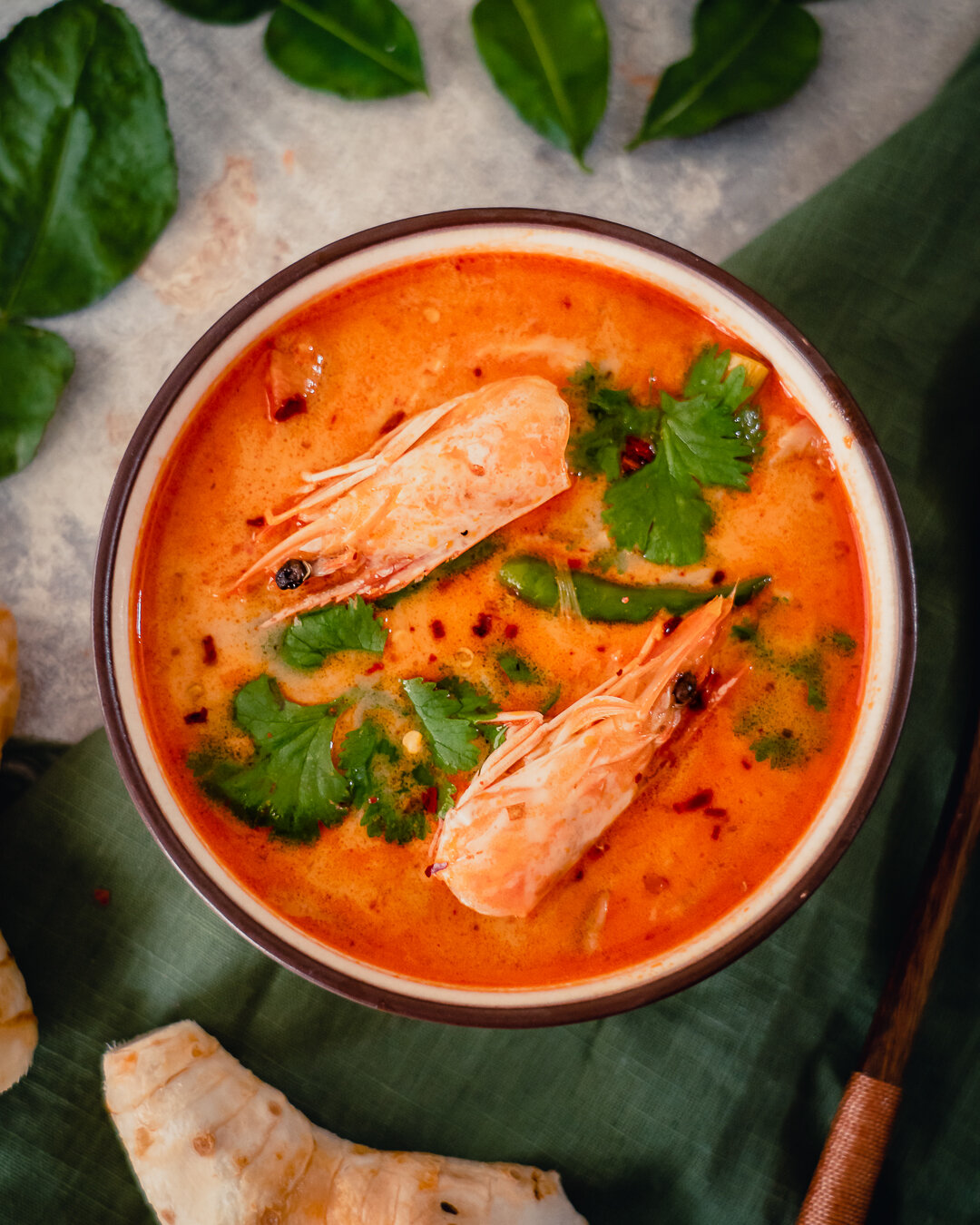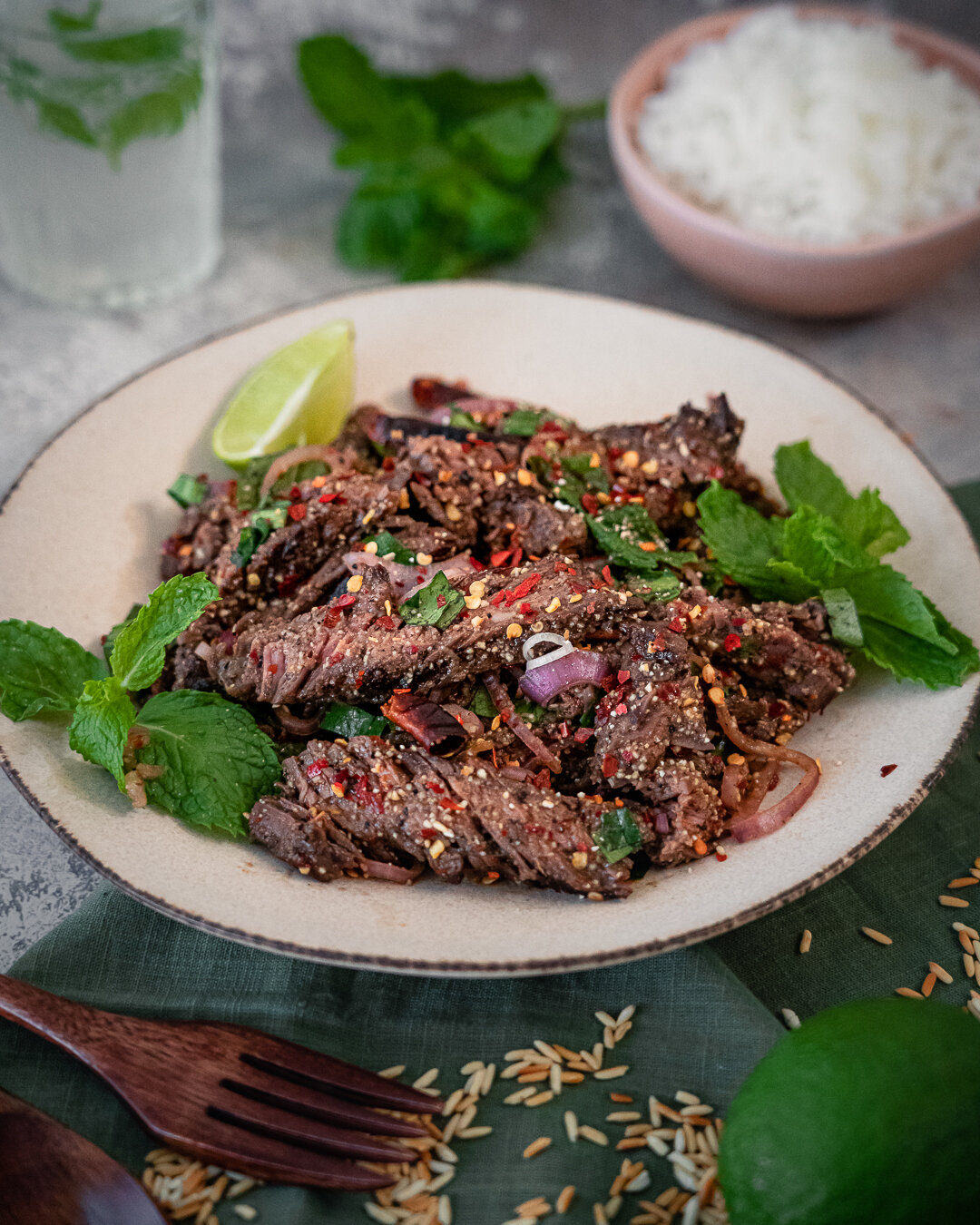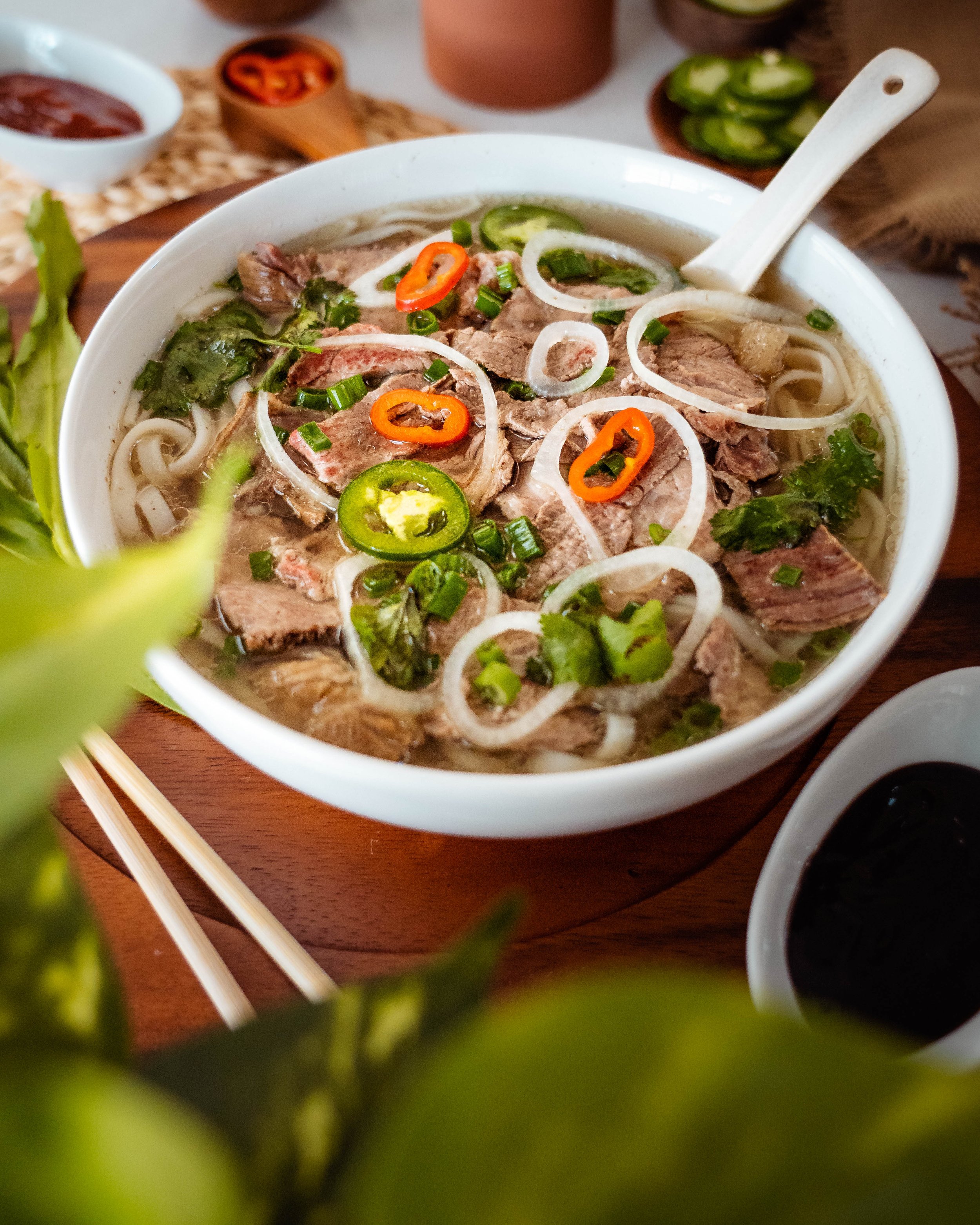Tom Yum Soup

Closing in on our journey into Thailand on a vibrant and bold note.
Tom yum goong nam khon — a creamy, hot and sour soup, cooked with fresh river prawns. This soup exhibits four clear flavors: unapologetic sourness, bold spiciness, distinct saltiness with notes of compromising sweetness. Featuring all four of the famous Thai flavors — salty, sour, sweet, and spicy, this soup is an amalgamation of the Thai holy trinity — lemongrass, galangal and kaffir lime leaves. I personally think tom yum goong is one of those dishes with all the flavors that represents Thai cuisine in one bowl.
In a nutshell, this is a creamy, spicy and herbal broth vibrant flavors of lime against the sweet and smoky taste of nam prik pao, a much loved Thai roasted chili jam. The addition of lime juice, and fish sauce melds harmoniously with the broth and gives it a legendary herbal kick at first bite. The protein components are chewy, tender mushrooms and fresh, plump prawns with their head still intact. The perfect tom yum goong should be a rich orange color. The vividness comes from the fatty juice in the head of the prawns; which adds to the aroma, color, taste and deliciousness of the soup. Don’t be shy. Be bold. 🦐
The meaning of Tom Yum Goong
The words "tom yam" are derived from two different Thai words. Tom refers to the boiling process and also a Thai verb which means “to boil”. Yum on the other hand means “mixed” and also a Thai noun for one of the four major types of salads found in Thailand. If you read my on Nam Tok Neua where I describe Thai salads, I am sure you will remember when I say “you can yum just about everything”. Just like the salad, the soup is also a balance of sour, sweet, salty and spicy. Goong is a Thai word with a broad meaning referring to both prawns and shrimps. All in all, the heart of tom yum goong is shrimp broth infused with fragrant herbs and dressed to taste similar to a typical yum salad.
What is Nam Khon?
The traditional tom yum broth is a clear soup or nam sai which becomes slightly richer in taste and more viscous with the help of fat from prawns heads. The one I am showcasing today is a more recent creation that took Thailand by storm in the last decade. The thick broth otherwise known as nam khon involves adding chili jam also called nam prik pao as well as evaporated milk or coconut milk. Having it both ways — nam sai and nam khon, I love the addition of coconut milk which makes it much richer and creamier, all the more comforting as we are shifting to colder seasons right now. I hear tom yum is also an excellent remedy for a cold or flu bug, the spices and herbs in the soup is meant to instantly clear your sinuses and warm you up. In fact, this Thai soup has undergone several scientific studies, as the ingredients appears to have immune-boosting and cancer-fighting abilities.
History
Although the exact history of Tom Yum Goong is not fully known, it is widely believed that this soup originated from Central Thailand. I did a fair bit of research reading up on the history of Tom Yum and there really wasn’t a lot of information. From what I gathered, this is usually the case when a dish is very ancient, one that preceded written recipes and has become such a part of the culture it does not need further explanation. Many say this central Thai soup was developed due to an abundance of freshwater shrimp in the Chao Phraya River. Boiled in water as a soup, the shrimp gave the broth a real fishy flavor, so cooks started experimenting by adding local Thai herbs into the broth to balance the fishy flavor. The trio of herbs that worked so well to infuse the broth with a beautiful aroma were lemongrass, galangal and kaffir lime leaves, which are still the three main component in any bowl of tom yum.
Starting from herb-infused shrimp or fish broth, tom yum kept developing through centuries reflecting the changes in Thai diet and availability of ingredients. For example, I discovered a very different tom yum recipe, first published in the 1890 in a Thai cookbook Tam Raa Gap Khao by Maawm Sohm Jeen. Named tom yum pla chon, the dish is more than just tom yum with snakehead fish or pla chon, the broth is enriched by fried chili paste and shredded green mango. At the same time, the recipe doesn’t include kaffir lime or galangal, but still the heart of it is a good fish broth, served with fish sauce and lime juice, giving it the desired spicy, salty, sour and sweet taste, characteristic of a typical tom yum. We can understand the evolution of Tom Yum as starting as a herb infused shrimp or fish broth, and then transforming through the centuries reflecting the changes in Thai diet and availability of ingredients in the locale it is being made.
Nowadays, we see tomatoes in Tom Yum at most Western Thai restaurants, probably because tomatoes come in abundance and adds an acidity where fresh ingredients like lemongrass and kaffir lime leaves can be hard to find. A really ancient Thai dish would hardly include tomatoes and chili as both were unknown to Thais before the Columbian exchange with the Americas. Adding straw mushrooms instead of coconut flesh is also unlikely to be an old feature, as shrimps and mushrooms are both sources of protein and duplicate each other. As I have mentioned in my other posts, the addition of coconut milk in savory dishes as well as dairy milk in Thai cuisine overall is a very recent phenomenon brought on by migrant communities like the Malay, Persians and Indians. The 1890 recipe is a good illustration of how diverse Thai tom yum was even 130 years ago. With shrimp or fish, straw mushrooms or coconut flesh, evaporated milk or coconut milk, tomatoes or shredded mango, it is still a soup loved by Thais and farangs as in foreigners around the world.
Time for my tried-and-true recipe.
Recipe: Tom Yum Goong Nam Khon
Serves: 2-4
A good Tom Yum must be boldly seasoned to be good, so don’t hold back on the seasonings. The soup should be primarily sour and then salty, with the sweetness coming from the nam prik pao, and it should be as spicy as you can tolerate.
Making the Shrimp Stock
Large Shrimps or Prawns, shell on and head on - 8-10
Clean the shrimp - peel and devein. Remove the heads and the shells from the shrimp. Set aside the shrimp. Reserve the heads and shells for making a shrimp stock.
Note: If you can’t find shell on shrimps at your local grocers, check the nearest Asian groceries. They always have large shell on and head on shrimps. If you don't want to make shrimp stock, you can use chicken or vegetable stock. It won’t have the authentic taste from the shrimp broth, but it does work as a decent substitute.
Oil - 1 tbsp
Water - 3 cups
Heat the oil in a medium saucepan over medium-high heat. Saute the shrimp heads and shells until they turn pink and orange bits start to form in the bottom of the pot - this is where the concentrated shrimp flavors are. Add water and scrape the bottom of the pan to release the orange bits. Bring the stock to a boil.
Cooking the Soup
Lemongrass - 2 stalks, smashed and cut into 3 inch pieces
Galangal - 4-5 thin round slices
Kaffir Lime Leaves - 4-6, torn into pieces and lightly bruised
Garlic - 2-3, lightly pounded
Bird’s Eye Chili - 4-8, bruised
Add lemongrass, galangal, kaffir lime leaves, garlic, and chilies. Simmer the stock gently in medium heat. After 25-30 minutes, strain the stock and discard all the aromatics, shrimp heads and shells.
Note: Traditionally, the lemongrass, galangal and kaffir lime leaves are left in the soup and people know they are not meant to be eaten. I personally like to remove it for ease of eating. If you are accustomed to eating Thai food, or don’t have a picky eater at home, you can add back the three aromatics back in the broth.
Coconut Milk - 1 cup
Oyster Mushrooms - 1 cup, or any other tender mushrooms like shimeji or enoki work too. Try not to use cremini or button mushrooms.
Large Shrimps or Prawns - 8-10, cleaned and reserved from earlier
Add the shrimp stock back in the saucepan over medium heat. Add coconut milk and let it come to a boil. Add the oyster mushroom and let it cook for 5 to 8 minutes. Turn the heat to medium-low and let the soup come to a gentle simmer. Add the shrimp and cook just until the shrimp is done, about 3 to 5 minutes. Try not to boil the shrimp to death, otherwise it will taste like rubber.
Note: I personally don’t like tomatoes in my Tom Yum. However, if the version you like contains tomato chunks, by all means, add about one medium tomato, cut into 1/2 inch chunks, to the simmering broth the same time you add the shrimps.
Seasoning the Soup
Nam Prik Pao (Thai Roasted Chili Jam) - 3 tbsp
Fish Sauce - 3 tbsp
Lime Juice - 4 tbsp
Add the roasted chili jam, fish sauce and lime juice in a mixing bowl. Stir to loosen the chili jam and combine well with the fish sauce and lime juice. Turn off the heat. Stir in the seasoning mix to the soup. Taste and adjust for spice and salt. If it’s not spicy enough, crush a few more bird’s eye chilies and add to the soup. If it needs more salt, you may add another tablespoon of fish sauce.
Cilantro leaves for garnish
Garnish with cilantro when ready to serve. Enjoy the soup on its own. Or you can pour the hot soup over a bowl of rice, as it is an entrée and traditionally eaten with rice.
If you do recreate our recipe, be sure to
TAG & FOLLOW @TheSpiceOdyssey
Stay up to date with us on Instagram, Pinterest, Youtube and Facebook.










